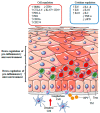How Human Papillomavirus Replication and Immune Evasion Strategies Take Advantage of the Host DNA Damage Repair Machinery
- PMID: 29257060
- PMCID: PMC5744164
- DOI: 10.3390/v9120390
How Human Papillomavirus Replication and Immune Evasion Strategies Take Advantage of the Host DNA Damage Repair Machinery
Abstract
The DNA damage response (DDR) is a complex signalling network activated when DNA is altered by intrinsic or extrinsic agents. DDR plays important roles in genome stability and cell cycle regulation, as well as in tumour transformation. Viruses have evolved successful life cycle strategies in order to ensure a chronic persistence in the host, virtually avoiding systemic sequelae and death. This process promotes the periodic shedding of large amounts of infectious particles to maintain a virus reservoir in individual hosts, while allowing virus spreading within the community. To achieve such a successful lifestyle, the human papilloma virus (HPV) needs to escape the host defence systems. The key to understanding how this is achieved is in the virus replication process that provides by itself an evasion mechanism by inhibiting and delaying the host immune response against the viral infection. Numerous studies have demonstrated that HPV exploits both the ataxia-telangiectasia mutated (ATM) and ataxia-telangiectasia and rad3-related (ATR) DDR pathways to replicate its genome and maintain a persistent infection by downregulating the innate and cell-mediated immunity. This review outlines how HPV interacts with the ATM- and ATR-dependent DDR machinery during the viral life cycle to create an environment favourable to viral replication, and how the interaction with the signal transducers and activators of transcription (STAT) protein family and the deregulation of the Janus kinase (JAK)-STAT pathways may impact the expression of interferon-inducible genes and the innate immune responses.
Keywords: ATM; ATR; DNA damage repair (DDR); IFN-γ; STAT-5; human papillomavirus (HPV); viral immune evasion.
Conflict of interest statement
The authors declare no conflict of interest.
Figures


Similar articles
-
Why Human Papillomaviruses Activate the DNA Damage Response (DDR) and How Cellular and Viral Replication Persists in the Presence of DDR Signaling.Viruses. 2017 Sep 21;9(10):268. doi: 10.3390/v9100268. Viruses. 2017. PMID: 28934154 Free PMC article. Review.
-
STAT-5 Regulates Transcription of the Topoisomerase IIβ-Binding Protein 1 (TopBP1) Gene To Activate the ATR Pathway and Promote Human Papillomavirus Replication.mBio. 2015 Dec 22;6(6):e02006-15. doi: 10.1128/mBio.02006-15. mBio. 2015. PMID: 26695634 Free PMC article.
-
Modulation of the DNA damage response during the life cycle of human papillomaviruses.Virus Res. 2017 Mar 2;231:41-49. doi: 10.1016/j.virusres.2016.11.006. Epub 2016 Nov 9. Virus Res. 2017. PMID: 27836727 Free PMC article. Review.
-
Human Papillomaviruses Preferentially Recruit DNA Repair Factors to Viral Genomes for Rapid Repair and Amplification.mBio. 2018 Feb 13;9(1):e00064-18. doi: 10.1128/mBio.00064-18. mBio. 2018. PMID: 29440569 Free PMC article.
-
DNA damage response is hijacked by human papillomaviruses to complete their life cycle.J Zhejiang Univ Sci B. 2017 Mar;18(3):215-232. doi: 10.1631/jzus.B1600306. J Zhejiang Univ Sci B. 2017. PMID: 28271657 Free PMC article. Review.
Cited by
-
HPV and co-infections: impacts on semen inflammation, oxidative stress, and sperm quality.Front Cell Infect Microbiol. 2025 Mar 26;15:1539871. doi: 10.3389/fcimb.2025.1539871. eCollection 2025. Front Cell Infect Microbiol. 2025. PMID: 40207057 Free PMC article.
-
Herpes Simplex Virus, Human Papillomavirus, and Cervical Cancer: Overview, Relationship, and Treatment Implications.Cancers (Basel). 2023 Jul 20;15(14):3692. doi: 10.3390/cancers15143692. Cancers (Basel). 2023. PMID: 37509353 Free PMC article. Review.
-
The impact of RNA modifications on the biology of DNA virus infection.Eur J Cell Biol. 2022 Jun-Aug;101(3):151239. doi: 10.1016/j.ejcb.2022.151239. Epub 2022 May 21. Eur J Cell Biol. 2022. PMID: 35623231 Free PMC article. Review.
-
Suppression of a Subset of Interferon-Induced Genes by Human Papillomavirus Type 16 E7 via a Cyclin Dependent Kinase 8-Dependent Mechanism.Viruses. 2020 Mar 13;12(3):311. doi: 10.3390/v12030311. Viruses. 2020. PMID: 32183180 Free PMC article.
-
Upsetting the Balance: When Viruses Manipulate Cell Polarity Control.J Mol Biol. 2018 Sep 28;430(19):3481-3503. doi: 10.1016/j.jmb.2018.04.016. Epub 2018 Apr 20. J Mol Biol. 2018. PMID: 29680664 Free PMC article. Review.
References
Publication types
MeSH terms
Substances
LinkOut - more resources
Full Text Sources
Other Literature Sources
Research Materials
Miscellaneous

